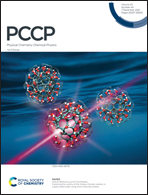Second harmonic generation-based nonlinear plasmonic RI-sensing in solution: the pivotal role of the particle size†
Abstract
Here, we demonstrate the utility of the second harmonic generation (SHG) for refractometric sensing in the solution phase. We employ an aqueous colloid of gold nanorods as our sensors, and modulation in their SHG with the surrounding refractive index (RI) is mirrored using second-harmonic light scattering (SHLS). A limit of detection (LOD) as low as 9 × 10−4 RIU is achieved. The RI sensitivity of our SHLS-based approach is two orders of magnitude higher than that obtained using linear Rayleigh scattering. Most importantly, we show that the particle size plays a crucial role in controlling the nonlinear plasmonic sensing performance of gold nanorods.

- This article is part of the themed collection: 2021 PCCP HOT Articles


 Please wait while we load your content...
Please wait while we load your content...